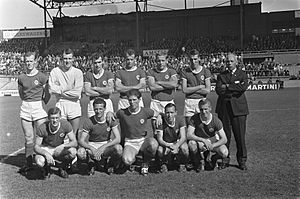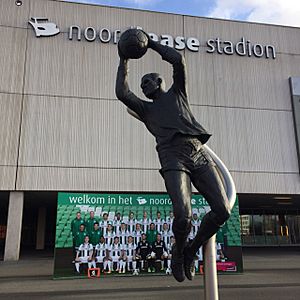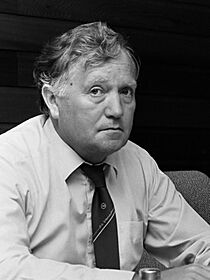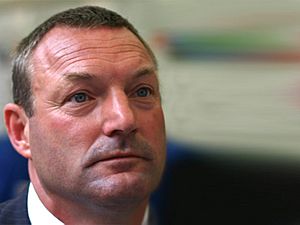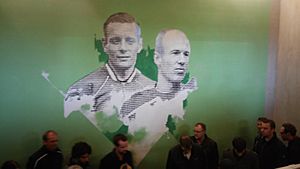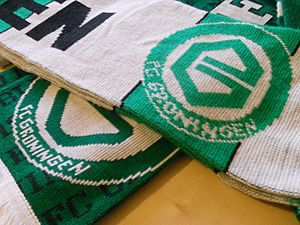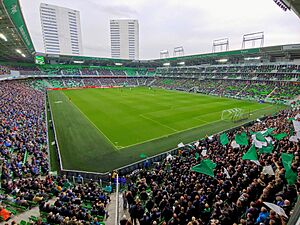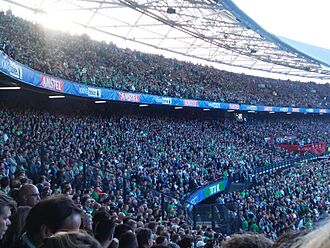FC Groningen facts for kids
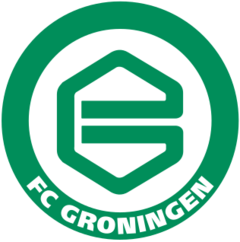 |
||
| Full name | Football Club Groningen | |
|---|---|---|
| Nickname(s) | Trots van het Noorden (lit. Pride of the North) De FC (lit. The FC) |
|
| Founded | 16 June 1971 | |
| Ground | Euroborg | |
| Capacity | 22,525 | |
| Owner | FC Groningen Beheer B.V. | |
| Chairman | Jakob Klompien | |
| Head coach | Dick Lukkien | |
| League | Eerste Divisie | |
| 2022–23 | Eredivisie, 18th of 18 (relegated) | |
|
|
||
Football Club Groningen, often called FC Groningen, is a professional football club from Groningen, a city in the Groningen province of the Netherlands. The club was started in 1971. It took over from an older club called GVAV. Today, FC Groningen plays in the Eredivisie, which is the top football league in the Netherlands.
FC Groningen played in the Eredivisie for its first three seasons. Then, in 1974, they faced money problems and were moved down to the Eerste Divisie, the second league. They worked hard and won the Eerste Divisie title in 1980. Most of the players at that time came from the club's own youth academy. FC Groningen stayed in the top league for 18 seasons. They were relegated again in 1998 but quickly returned to the Eredivisie in 2000. They remained there for 23 seasons. In 2023, they were relegated once more. However, they bounced back quickly, finishing second in the 2023–24 Eerste Divisie season and earning promotion back to the Eredivisie.
The club has won the KNVB Cup once, in 2015. They were also runners-up in 1989. Their best league finish was third place in 1991. FC Groningen has also played in European tournaments several times. Their first European match was in 1983, where they beat Atlético Madrid. Famous players like Erwin Koeman, Ronald Koeman, Arjen Robben, and Virgil van Dijk all started their careers at Groningen. Luis Suárez also played for Groningen when he first came to Europe.
FC Groningen's first home stadium was the Oosterparkstadion. Since 2006, they have played at Euroborg. The team's home kit colors are green and white, matching the city's coat of arms. The club is known as "Trots van het Noorden," which means "Pride of the North." They have a rivalry with Heerenveen, a team from the nearby region of Friesland. This match is called the Derby van het Noorden.
Contents
Club History
How FC Groningen Started
The club's story began with GVAV, which was founded in 1921. GVAV was one of the first teams in the Eredivisie when it started in 1956. At that time, there were a few professional football teams in Groningen. However, GVAV soon faced big money problems. To help, a special foundation was set up in 1963. It included GVAV, the city council, and local businesses. Each put in money to help the club.
Despite this help, GVAV's money troubles continued. This put the future of professional football in Groningen at risk. GVAV was the only professional team left in the city. They were moved down to the Eerste Divisie in 1970. In February 1970, Harm Brink, who led an amateur club, suggested creating a new professional team for Groningen. Many local amateur clubs supported his idea. The city and businesses agreed to clear GVAV's debts. In September 1970, most GVAV members voted for Brink's plan. GVAV then won promotion back to the Eredivisie. On June 16, 1971, Football Club Groningen was officially founded as the new professional club. GVAV then went back to being an amateur club.
During the 1970–71 season, GVAV's goalkeeper, Tonny van Leeuwen, was amazing. He let in the fewest goals of any goalkeeper in Dutch football. He was honored for this achievement. Sadly, Van Leeuwen died in a car accident on his way home, just one day before FC Groningen was founded. FC Groningen played its first match on July 17, 1971. They beat a German team, TSR Olympia Wilhelmshaven, 6–0. The team wore green and white kits, which are the colors of the city's coat of arms.
Early Challenges and European Adventures (1971–1991)
FC Groningen lost its first league game 1–0 at home. About 13,000 fans watched the match against FC Utrecht. The team got its first league win on the 10th game day, beating Vitesse 2–1. They finished their first season in 12th place. The club still had money problems. To save money on buying players, Groningen started its own scouting system. In 1974, they had a very tough loss, 9–0, against Ajax. They finished last in the league and were moved down to the Eerste Divisie. The city council helped save the club from almost going bankrupt.
In 1975, Groningen started a youth boarding school. This was part of their plan to build the team with players from their own academy. They slowly improved. In 1980, under coach Theo Verlangen, Groningen won the Eerste Divisie title. They lost only 4 out of 36 matches that season. Most of the players who helped them win promotion came from Groningen's youth academy.
In the 1982–83 season, FC Groningen finished 5th in the Eredivisie. This meant they qualified for a European competition for the first time. This was the 1983–84 UEFA Cup. A key player, Ronald Koeman, left the club in 1983 to join Ajax. His brother, Erwin, stayed with Groningen. Both brothers had started their careers at Groningen. The team's first European game was away against Atlético Madrid. They lost 2–1 but won the return game 3–0, winning 4–2 overall. In the next round, they faced Inter Milan. Groningen won 2–0 at home but lost 5–1 away, so they were knocked out. Groningen played in European competitions five more times between 1986 and 1992.
By the mid-1980s, Groningen became a mostly professional team. The club also had the fourth-highest average attendance in Dutch football. More than 10,000 fans came to each match. In 1989, Groningen reached their first KNVB Cup final but lost 4–1 to PSV. Around this time, the club faced more financial issues related to its chairman, Renze de Vries. He stepped down, and the club was left with a lot of debt. Despite these problems, the team had its best-ever league finish in 1991, coming in third place. They even competed for the league title for most of the season. After the season, Groningen's player Henny Meijer was named Dutch Footballer of the Year.
New Home and First Major Trophy (1991–2021)
After 1991, Groningen's performance in the league started to decline. They were eventually moved down to the Eerste Divisie again in 1998. The club had little money and changed coaches often, trying to find success. They returned to the Eredivisie in 2000 after winning their promotion play-off group. In that season, Groningen set several club records. They scored 81 goals, won 10 matches in a row, and had their biggest win ever: 10–1 against DVS '33 in the KNVB Cup. In December 2000, a 16-year-old player named Arjen Robben made his first professional appearance. Robben, who later became one of the world's best players, was soon sold to PSV for a large fee. Groningen managed to avoid relegation in their first few seasons back in the Eredivisie. Under coach Ron Jans, who joined in 2002, the team started to climb back into the top half of the league.
In January 2006, FC Groningen moved from the old Oosterparkstadion to the new Euroborg stadium. The Oosterparkstadion had been the club's home since the 1930s. With the new stadium, the average number of fans at home games grew from 12,000 to about 20,000. Groningen did not lose any of their first 15 league games at Euroborg. The stadium quickly earned the nickname "De Groene Hel," meaning "The Green Hell." In the 2005–06 season, the team finished fifth. This allowed them to play in a special play-off for a spot in the UEFA Champions League. They reached the final but lost to Ajax. However, they still qualified for the 2006–07 UEFA Cup. Groningen qualified for the UEFA Cup again the next season but were knocked out by Italian team Fiorentina after a penalty shootout. In 2010, coach Jans left and was replaced by former Groningen player Pieter Huistra.
In the 2010–11 season, Groningen finished 5th under Huistra. They reached the European play-off final again. They almost came back from a 5–1 deficit against ADO Den Haag but lost after a penalty shootout. In 2014, coach Erwin van de Looi led Groningen to win the European play-off final. This meant they qualified for the 2014–15 UEFA Europa League. They were eliminated by Aberdeen in the second qualifying round. However, Groningen achieved their first major honor that season. They beat PEC Zwolle 2–0 in the 2015 KNVB Cup final. This made them the third team from Groningen to win a major trophy. By winning the cup, they qualified directly for the 2015–16 UEFA Europa League group stage. They only got two points from six matches and finished last in their group. In 2019, Hans Nijland, who had been the club's CEO since 1996, stepped down. He was replaced by Wouter Gudde.
Recent Relegation and Quick Return (2021–Present)
In the 2022–23 season, FC Groningen finished last in the Eredivisie. They won only 4 out of 34 matches and were moved down to the Eerste Divisie for the third time in their history. Before that season, German coach Frank Wormuth was appointed. He was let go in November 2022. Under his replacement, Dennis van der Ree, Groningen won only one match out of 21. They were also knocked out of the KNVB Cup at home by an amateur club. Wouter Gudde, the CEO, said the team was not strong enough and lacked "personality."
However, under coach Dick Lukkien, FC Groningen had a great 2023–24 season. They finished second in the Eerste Divisie and were promoted back to the Eredivisie. Many of the players on the team had come through the club's own youth academy. They secured second place by beating their direct rivals, Roda JC, 2–0 on the very last day of the season.
Club Crest and Colors
Soon after FC Groningen was founded in June 1971, a local newspaper held a competition to design a crest for the new club. The winning design came from Reint Rozema, a 21-year-old designer. His design featured an abstract letter "G" to represent Groningen. In 1993, a board member added a Pegasus (a winged horse) to the badge. This was meant to make the club look more "dynamic and aggressive." However, fans and local media did not like it. So, in 1996, the Pegasus was removed, and the original crest was brought back.
FC Groningen's kit colors have been green and white since the club started. These colors come from the city's coat of arms. In the very first seasons, the team also sometimes played in a purple shirt. For a few years, Groningen's jerseys did not have a sponsor's logo. In 1975, Adidas became the first company to have its logo on the club's shirt. The first sponsor's name to appear on the shirts was AGO, an insurance company, from 1982 to 1983. Since then, the club has had many different kit makers and shirt sponsors. Until 1991, the home kits used different patterns of green and white. Then, they adopted a white shirt with two vertical green stripes.
Home Stadium
Since January 2006, FC Groningen has played its home matches at Euroborg. This stadium replaced the Oosterparkstadion, which had been the home of GVAV and Groningen since the 1930s. The Dutch national team played two international matches at the Oosterparkstadion in the 1980s. In 1985, Groningen had its largest attendance at the Oosterparkstadion. About 21,500 fans watched a 1–1 draw against Feyenoord.
The club first thought about building a new stadium in 1996. The Oosterparkstadion was getting old and only held about 12,500 people. In 2004, construction began on Euroborg. The stadium was designed by architect Wiel Arets. It officially opened on January 13, 2006, with a match against Heerenveen, which Groningen won 2–0.
Euroborg hosted the final of the 2007 UEFA European Under-21 Championship. In that game, the Netherlands beat Serbia 4–1. In 2014, Groningen became the first Dutch club to install its own solar power plant. More than 1,000 solar panels were put on the stadium's roof. This was done to make the club more eco-friendly. The stadium hosted its first senior women's international match in 2017. The Dutch women's team played against Norway. In June 2025, it hosted its first senior men's international game. The Netherlands beat Malta 8–0 in a World Cup qualifier.
Euroborg can hold 22,525 spectators. It is nicknamed "De Groene Hel" (The Green Hell) and "De Groene Kathedraal" (The Green Cathedral). The stadium has four main stands. These are named after important figures like Tonny van Leeuwen, Piet Fransen, and the Koeman family.
Supporters and Rivalries
FC Groningen's fans mostly come from the provinces of Groningen and Drenthe. In the club's early years, and when it was GVAV, they also had many fans in Friesland. This was because they were the only northern team in the Eredivisie at the time. This is how they got the nickname "Trots van het Noorden" (Pride of the North). In the late 1970s, a group of dedicated fans called the Z-side formed. The Z-side and other fan groups from Groningen have long-standing friendships with fan groups from clubs like Roma (Italy), Beerschot (Belgium), and Rot-Weiß Erfurt (Germany). Groningen fans also have a long friendship with supporters of Scottish team Hibernian since the 1990s.
Since FC Groningen is one of the few professional teams in the Northern Netherlands, and the only one from Groningen province, they do not have many strong rivalries. Until 2013, when local team Veendam was dissolved, Groningen played against them in the Groningse derby. These teams only met four times in the Eredivisie. Veendam mostly played in lower leagues. In the 1990s, Groningen had intense matches with Twente.
Around the same time, a local rivalry grew between Groningen and the Frisian club Heerenveen. This is known as the Derby van het Noorden. This rivalry became stronger in the 2000s. Fans of both clubs would play pranks on each other. For example, Groningen fans once painted a statue of Heerenveen's famous player Abe Lenstra in green and white. However, this rivalry started to fade in the mid-2010s. Another Frisian club, Cambuur, was promoted to the Eredivisie. Heerenveen now sees Cambuur as their main rival.
Players
First-team squad
|
|
Players on Loan
|
Club Management
Football Management Team
| Position | Name |
|---|---|
| Head coach | Dick Lukkien |
| Assistant coaches | Casper Goedkoop Mischa Visser |
| Chairman | Jakob Klompien |
| Chief executive officer | Frank van Mosselveld |
| Chief operating officer | Marc-Jan Oldenbandringh |
| Director of football | Mohammed Allach |
Head Coaches Through the Years
Ron Groenewoud was FC Groningen's first coach. He was in charge when the team was relegated to the Eerste Divisie in 1974. Theo Verlangen led the team to win the Eerste Divisie title in 1980. He also helped them qualify for their first European competition in 1983. Groningen had its best league finish, third place, under coach Hans Westerhof in 1991. After being relegated in 1998, the team won promotion back to the top league in 2000 with Jan van Dijk as coach. Erwin van de Looi led Groningen to win their first major trophy, the 2014–15 KNVB Cup. The German coach Frank Wormuth was the club's first foreign coach when he took the job in 2022. Under Dick Lukkien, the team won promotion back to the top league in 2024.
Club Achievements
- Eerste Divisie (Second Tier)
- Winners: 1979–80
- Promoted: 2023–24
- Promotion play-off winners: 1999–2000
- KNVB Cup
- Winners: 2014–15
- Runners-up: 1988–89
- Johan Cruyff Shield
- Runners-up: 2015
Club Records and Statistics
The player with the most appearances for FC Groningen is Jan van Dijk. He played 537 games for the club between 1975 and 1992. The club's top goal scorer is Peter Houtman, who scored 128 goals in three different periods with Groningen. He also holds the record for most goals in a single season, scoring 31 times in 1977–78. In 1991, Henny Meijer won the Dutch Footballer of the Year award. He is the only Groningen player to have achieved this so far.
The youngest player to play for the club was Richairo Živković. He was 16 years and 88 days old when he made his debut in 2012. The oldest player to appear for Groningen was goalkeeper Peter van der Vlag. He played his last match at 37 years and 163 days old in 2015.
FC Groningen's biggest win was a 10–1 victory against DVS '33 in the 1999–2000 KNVB Cup. Their largest win in a league match was 7–1 at home against Willem II in 2010–11. The club's biggest loss was 9–0 to Ajax in 1973–74. The highest amount of money Groningen has received for selling a player was €11 million. This was for Norwegian striker Jørgen Strand Larsen in 2022. The most money the club has paid for a player was €3.3 million for Nigerian midfielder Oluwafemi Ajilore in 2008.
See also
 In Spanish: Football Club Groningen para niños
In Spanish: Football Club Groningen para niños


